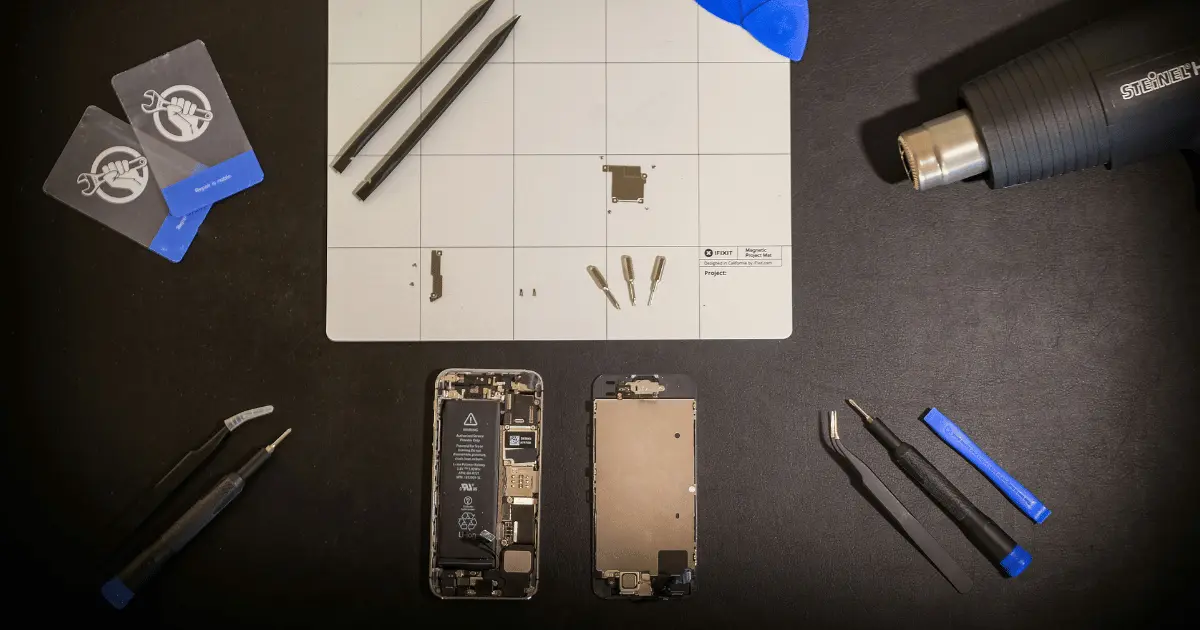A customer is desperate to get their iPhone fixed before an important meeting.
You take the device and confidently say you can turn the repair around in an hour. But as you start the repair process, you realize you’re missing the tool you need. The customer gets impatient and you scramble around wishing you’d invested in the proper electronics repairing tools.
For cell phone repair business owners, this is a familiar story. But it’s avoidable! Investing in high-quality, specialized repair tools is worthwhile.
This quick guide highlights the seven must-have tools for every cell phone repair business. From multimeters and soldering stations, you’ll be ready to stock your repair shop and never miss a sale again.
Electronics Repairing Tools: Invest in Your Store
Before we dive into the specific tools you need, let’s look at why you should invest in the best tools.
Electronics repairing tools are specialized instruments designed to help you diagnose, disassemble, repair, and reassemble electronic devices, such as smartphones, tablets, and laptops.
Related Read: 7 Tips for Managing an Electronics Repair Business
Investing in high-quality tools:
- Helps you work efficiently, completing repairs quickly and accurately. The more customers you serve, the more revenue you generate.
- Ensures high-quality repairs, reducing the risk of damage to devices.
- Shows professionalism. A well-equipped toolkit helps demonstrate your technical skills and builds trust with customers.
On the other hand, only having basic tools:
- Risks damaging delicate components of electronic devices. Not only will you upset customers, but you’ll incur costs and wipe out your profit.
- Makes the repair process longer, leading to a backlog of customers and stressed technicians.
- Damages your reputation. Customers trust you with expensive devices — if you provide poor service, they won’t recommend you when a friend or family member needs a repair.
Investing in proper electronics repair tools provides a win-win — customers leave happy, and you make more revenue.
As you build your collection of electronics repairing tools, it's important to keep track of your inventory. It's easy to manage your tool inventory with a point of sale (POS) system designed just for repair shops.
A POS system streamlines inventory management with features like low stock alerts and automatic reordering, letting you focus on providing excellent customer service.
Now, let’s look at seven must-have (plus three bonus) tools for your repair store.
Tool #1: A Multimeter
A multimeter is a handheld device used to measure voltage, current, resistance, and other electrical properties. It’s essential for diagnosing and troubleshooting electronic device issues.
If a customer brings in a phone that won’t charge, use the multimeter to test the charging port's voltage and continuity. If the multimeter can’t pick up any voltage, you know you need to replace the charging port.
When choosing a multimeter, opt for a reputable brand. Although buying a cheaper version might save you some money in the short term, you might end up needing to replace it further down the line.
Last, get a digital multimeter that has a clear display with high accuracy and a wide measurement range.
Related Read: Cell Phone Repair Parts: 5 Best Suppliers
Tool #2: Soldering Station
Your technicians need the best tools to do a great job. If your technicians handle board-level repairs, they need a soldering iron, a stand, and a power supply that lets them control the iron’s temperature.
In cell phone repair, a soldering iron is used to:
- Replace damaged or malfunctioning components like charging ports, speakers, and microphones
- Repair broken traces on circuit boards
- Modify circuit boards to upgrade or replace components
You can get analog soldering stations with a simple dial to control the temperature. They’re more affordable. A digital soldering station is more precise and often includes features like programmable temperature profiles and standby modes.
On the more expensive side, hot air rework stations include a hot air gun, which is useful for tasks like removing and replacing surface-mounted components.
Related Read: Inventory Management for Electronics: 5 Digital Inventory Tools
Tool #3: Precision Screwdriver Set and Pry Tools
Precision screwdrivers and pry tools are essential electronics repairing tools. They let you quickly and safely disassemble and reassemble electronic devices without causing damage.
Cell phones use various tiny screws to hold components in place, and these screws often require specialized drivers. A good precision screwdriver set will include a range of bits to fit the most common screw types found in cell phones, such as:
- Phillips: Used in many Android devices and older iPhones
- Pentalobe: Used in newer iPhone models
- Torx: Used in some Samsung and LG devices
- Tri-point: Used in some iPhone and iPad models
Pry tools help separate the layers of a cell phone, such as the screen from the frame. Different pry tools perform different tasks:
- Spudgers pry apart components and disconnect cables and connectors.
- Triangle picks separate the screen from the frame and remove batteries.
- Thin pry tools can get into tight spaces and remove delicate components like cameras.
To help your repair technicians, look for high-quality materials, ergonomic handles, and magnetic tips.
Pro tip: It’s worth investing in a magnetic board or project mat. Simply a mat with a magnetic surface, it’s great for keeping small parts and tools secure while you work. There are so many tiny screws and parts that could roll away and get lost — a magnetic mat solves this problem.
Tool #4: Heat Gun and LCD Separator Machine
Two essentials for tackling screen replacements are a heat gun and an LCD separator machine. Together, these tools safely remove damaged screens and prepare the device for a new one.
First, the heat gun blows hot air and softens the adhesive holding the screen in place. When you apply heat to the edges of the screen, you can loosen the adhesive without damaging the delicate components underneath.
An LCD separator machine, also known as a screen separator or vacuum separator, is a specialized tool designed to safely separate the screen from the frame after the adhesive has been softened with a heat gun.
Pro tip: Use a heat gun with adjustable temperature settings and various nozzle attachments for different applications.
Related Read: Cell Phone Repair Store Profits: 5 Tips To Improve Your Bottom Line
Tool #5: Isopropyl Alcohol and Cleaning Tools
Cleaning is a crucial part of the repair process. It shows customers that you care and also increases the longevity of your repairs. Two essentials are isopropyl alcohol and a variety of cleaning tools.
Also known as rubbing alcohol, isopropyl alcohol is an effective cleaning agent for electronic components. It evaporates and leaves no residue, and it’s safe to use on most surfaces found in cell phones. Use it to:
- Remove dirt, grime, and oxidation from connectors and contacts so there’s a clean connection.
- Clean any adhesive residue left on surfaces once you remove a screen or other components.
- Remove dust and debris that might cause short circuits or other issues.
As well as rubbing alcohol, you need various cleaning tools, such as soft-bristled brushes, microfiber cloths (that don’t leave behind fibers or scratches), cotton swabs, or Q-tips, and canned compressed air for hard to reach places.
Pro tip: Always consult the manufacturer or their guidelines before using cleaning products, as some may require a different concentration or cleaning method.
Tool #6: Ultrasonic Cleaner
This device uses high-frequency sound waves to create millions of tiny bubbles in a cleaning solution, creating a powerful scrubbing action that removes dirt, grime, and debris from electronic components.
An ultrasonic cleaner cleans motherboards, connectors, speakers and microphones, and small parts. It has various benefits:
- Efficiency: It can clean multiple components simultaneously, saving you time and labor.
- Thoroughness: The powerful scrubbing action removes things you might not reach by hand.
- Safety: You won’t need to clean delicate components by hand, reducing the risk of damaging parts.
- Consistency: Every component is cleaned to the same standard.
You might prefer to do things by hand rather than use a machine, but an ultrasonic cleaner can help if your cell repair store is growing fast.
Tool #7: Mobile Phone Diagnostic Software
Mobile phone diagnostic software assesses, troubleshoots, and analyzes mobile devices. You can run comprehensive tests on hardware and software performance, and connectivity issues. With diagnostic tools, you can:
- Diagnose problems faster
- Identify faults
- Generate reports for customers
…and more.
To see the must-have features and who we recommend for mobile phone diagnostic software, check out our breakdown here: Mobile Phone Diagnostic Software: Top 5 Providers.
Bonus Electronics Repairing Tools To Consider
While the following tools aren’t essential, they make nice additions to your toolset:
- Magnifying glass: Great for inspecting connectors and solder joints, reading tiny labels, markings, or part numbers on components.
- Suction cup pliers: Also known as vacuum pliers, this tool uses suction to securely grip and lift fragile components, like glass screens or back covers.
- Fine-tipped curved tweezers: Designed with a precise, curved tip, you can reach into tight spaces and manipulate small components with greater control and accuracy.
These are worthy additions to consider for your electronics repairing tools collection.
Electronics Repairing Tools: Manage Them With Ease
The tools above will help you provide a great service to your customers and empower your technicians to perform quality repairs. A workman is only as good as his tools.
Having all the right tools and parts in stock is essential to running a cell phone repair business. To manage it all, it’s worth investing in a POS system designed specifically for repair shops. A repair shop POS can help you:
- Keep a real-time inventory of your tools, including quantities, locations, and maintenance schedules, so you always know what’s on hand and what you need to replace.
- Track the costs of your tools and supplies so you can price repairs and turn a profit.
- See which tools your technicians use the most and which are underutilized to help inform future purchases.
- Manage repair tickets, repair quotes, and detailed repair policies.
…and more.
CellSmart POS takes the guesswork out of managing your electronics repairing tools inventory. With inventory management, purchase orders, and reporting, our repair shop POS is the perfect addition to your toolset.
Check it out for yourself and schedule a free demo today.





